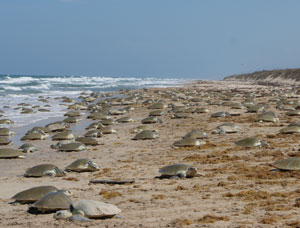Agencies partner to help save endangered Kemp’s ridley sea turtles
NOAA signs bi-national recovery plan for endangered species
September 22, 2011

Kemp's ridley turtles are seen during the June 5, 2011 arribada, or mass nesting of turtles, at Rancho Nuevo, Mexico.
(Credit: Toni Torres, Gladys Porter Zoo)
NOAA’s Fisheries Service, the U.S. Fish and Wildlife Service, and Mexican environmental officials today released an updated plan to guide and strengthen the conservation and recovery of the endangered Kemp’s ridley sea turtle. The Bi-National Recovery Plan revises the current recovery plan issued in 1992.
The recovery plan updates the conservation efforts that have proved successful for the Kemp’s ridley. The plan also guides the implementation of research programs that improve understanding of how human activities and natural processes affect the species. The plan also provides criteria for delisting the species. If population growth and recruitment maintain their current rates of increase, scientists estimate Kemp’s ridleys may attain an important delisting criterion of 40,000 nesting females per season over a 6-year period by 2024.
“We are working together with other U.S. and Mexican agencies on the recovery of the Kemp’s ridley, and we are seeing results,” said Eric Schwaab, assistant NOAA administrator for fisheries. “Cooperation among government agencies, fishermen, local communities and ocean users is the key to continuing our success, and this new updated plan will help us to continue in our efforts to save this species. We are well on our way, but we still have a long way to go.”
The recovery plan, based on the best available science, highlights the past bi-national conservation efforts that have led to the increase in the Kemp’s ridley nesting population. It also discusses the natural history, current status, and the known and potential threats to the Kemp’s ridley sea turtle.

Kemp's ridley turtle swimming at the waters surface.
(Credit: Kim Basso, Hull Mote Marine Lab)
“The results of our partnership, and how effectively we are able to work together, were demonstrated this year when a record number of nests were identified along the Texas coast,” said Benjamin Tuggle, U.S. Fish and Wildlife Service southwest regional director. “In addition to that achievement, on a single day this June, a massive arribada – a group nesting event – of about 9,000 Kemp’s ridleys was seen on the main nesting beach in Mexico.”
Since the mid-1980s, scientists have documented an approximate 15 percent increase in Kemp’s ridley nests per year at the species’ main nesting beaches along the northeast coast of Mexico. Currently, the Kemp's ridley, once the most imperiled of all the sea turtle species, is close to meeting one of the major recovery criteria for downlisting to threatened from endangered under the Endangered Species Act.
Kemp's ridleys face threats on both nesting beaches and in the marine environment. The greatest cause of decline and the continuing primary threat to the Kemp's ridley is incidental capture in near shore fishing gear, primarily in shrimp trawlers, but also in gill nets, longlines, traps and pots, and fishing dredges in the Gulf of Mexico and North Atlantic. The recent BP Deepwater Horizon oil spill in the northeastern Gulf of Mexico affected critically important offshore habitats for young Kemp’s ridley sea turtles, and many were directly exposed to oil. The long-term effects of this oil spill are not yet known but are of concern for the species recovery.
Egg collection by locals for food was an extreme threat to the population, but since nesting beaches were afforded official protection by Mexico in 1966, this threat no longer poses a major concern.
“Mexico recognized early on the importance of protecting the main Kemp’s ridley nesting beaches on their coast,” said Jim Lecky, Director of NOAA Fisheries Office of Protected Resources. “All of our agencies working together, with concerned citizens and groups in both our countries, have helped set the Kemp’s ridley on the path to recovery. This Bi-National Recovery Plan keeps us all heading in the right direction.”
To view the Bi-National Recovery Plan and learn more about the Kemp’s ridley turtle and recovery efforts, visit:
http://www.nmfs.noaa.gov/pr/recovery/plans.htm#turtles
http://www.nmfs.noaa.gov/pr/species/turtles/kempsridley.htm
USFWS Kemp’s ridley: http://www.fws.gov/kempsridley/index.html
NOAA’s mission is to understand and predict changes in the Earth's environment, from the depths of the ocean to the surface of the sun, and to conserve and manage our coastal and marine resources. Join us on Facebook, Twitter and our other social media channels.
The mission of the U.S. Fish and Wildlife Service is working with others to conserve, protect and enhance fish, wildlife, plants and their habitats for the continuing benefit of the American people. We are both a leader and trusted partner in fish and wildlife conservation, known for our scientific excellence, stewardship of lands and natural resources, dedicated professionals and commitment to public service.
